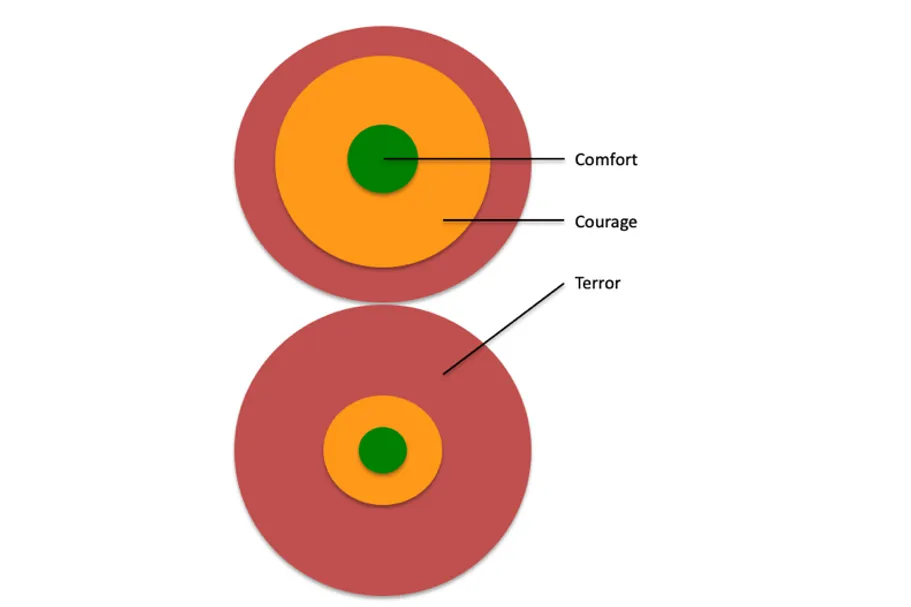The first step to becoming an effective open water swimmer is being relaxed in an open water environment. For many, the fear of this kind of swimming is about the unknown. Water depth falls into this category.
Open water swimming often takes place in locations where you are unlikely to know the actual depth. Unless you are fortunate enough to swim in warmer climates, it is doubtful that you can see the bottom. You could be swimming in water shallower than the pool, or deeper than your house - you just wouldn’t know.
The truth is that everyone is different, for some seeing the bottom is terrifying and for others, not knowing what is underneath you is the concern. So if you find yourself fearful of deep water, then you need to start with dissecting that fear and understanding what it is and what actually spooks you. This may mean you need to put yourself in safe but fear-inducing positions to find out, or it may be you already know.
How do you overcome the fear of deep water, so you can swim confidently?
How do you overcome any fear? The first thing to understand is that you can't overcome fear when it has gripped you tight. Do not expect to go out and swim in deep water and be ok with it the first time after reading this. Because the reality is that anxiety or fear elicits a response that in water makes everything seem worse:
- Panic
- Shortness of breath
- Shallow breathing
- Adrenaline-fuelled movements
- Clouded mindset or judgement
- Elevation of heart rate
If any of those happen in an open water environment, you will likely find that the reaction exacerbates the fear. If we take breathing as an example, it is hard to focus on deep, controlled breathing to calm you down when your head is submerged or when exercising.
The obvious question you have to ask yourself is, how will any of the above responses to fear help you? And if your response is none of them, then what would help you? How can you work on things that are more likely to help, than hinder you?
Guidelines about overcoming fear usually talk about facing it, breathing through it, looking at it logically (ask yourself 'how many people have safely swum over that deep bit?'), and explore the worst possible outcome. All these methods identify two key points; firstly, you need to accept that you have that fear and secondly, they work on bringing control to it by normalising the experience.
Furthermore, you must recognise that this takes a lot of time. Taking baby steps forward is a lot better than taking giant leaps oscillating between a step forward and a step backwards. How can you breakdown this fear into tiny steps that you can achieve, see progress and ultimately trust?
How can I become a more confident swimmer in deep water?
The first thing to do is to break down the fear as much as possible. For example, can you swim in deep water with your head up rather than submerged? What about swimming in clear water? does the fear typically surface only when it is the first time that you swim somewhere? Secondly, you need to define where your comfort level is and where the limit is of what you are comfortable being challenged. If the ultimate aim is to be able to swim a point-to-point race between two islands, and you currently can’t swim in your lake further than 50m as you can’t see the bottom, then there will be a lot of steps you will need to take to get to that point. That is ok. These two steps provide you with an endpoint and a starting point.
Everyone is unique and how each person will respond to facing these fears and the severity of the fear itself will be different. It may mean that it could take a long time before the swimmer can swim to the first buoy 100m away, or it could be one session. However, each time you persist in your fear, you are exploring the envelope of where that line between courage and terror is, and the limit of comfort and courage. Over time, you are shifting where your comfort zone lies.

The best example is a 10m diving platform and being scared of heights. On day one, you may only aim to put one foot on the ladder; on day two, the idea would be to get both feet off the ground. Down the line, it may be to get to the 3m springboard until, eventually, you can stand on the edge of the 10m diving platform. Unlike open water swimming, there are clear steps (literal ones) that you can make to progress forwards to the goal of getting up to the 10m point. We are trying to dissect the fear of deep water in open water swimming in a similar, tangible, and simple way so that you can make those steps forwards, recognise you have made progress, and reward yourself. It is easy to diminish any achievement by comparing it to the end goal. But if you look at the aim of going from one foot on the rung to both feet of the rung, you have just made a 100% improvement and though it won’t be at 10m yet, it is significant progress. Always celebrate and focus on that progress. In open water, this may be swimming five strokes, then lying on your back or swimming breaststroke around the first buoy without your head in the water.
What can I do if I feel panic about the deep water coming on?
It can be really easy to get scared, panic and make the situation far worse in the open water environment. To avoid the situation getting unnecessarily out of hand, you need to have a way of getting out of the challenging environment quickly, so you know there is always a safe way out. This knowledge will make the whole experience better and increase your chances of success.
For some people, this may be breathing; for others, it may be holding onto a canoe, and for a few, it may be getting out of the water. Either way, work on something that you can do which will help you regain control of the situation. As a coach, I like assisting athletes in realising that they can lie on their backs in a wetsuit, and they will almost certainly float. If they have a tow float, they can hold that too. Then they can focus on deep breaths and regaining control. This is their coping mechanism, which they can use at any time as canoes won’t always be nearby.
Finally, when you face these challenges away from a practice environment (a race or a deliberate swim session, rather than training for deep water), then you should focus on what you are doing. Technical cues and mantras on breathing usually help take your mind off any negative, fearful thoughts and into something you can control: “exhalations”, “hand to hips”, or whatever works for you.
Above all, don’t rush this. It takes time, and if you want to overcome any fear, you need to do so gently, kindly and patiently – it takes courage to do this, so celebrate each step forwards and look back to see how far you have come. Good luck.
Find more open water swimming advice, tips and training sessions here
Philip Hatzis is a BTF Level 3 qualified coach and Ironman certified coach. He is the founder and head coach of Tri Training Harder. He has taken many of his coached athletes to World and European Championships in all distances, including both Ironman and ITU, to both medal and compete. As an athlete he has competed at the Ironman World Championships in Kona.
